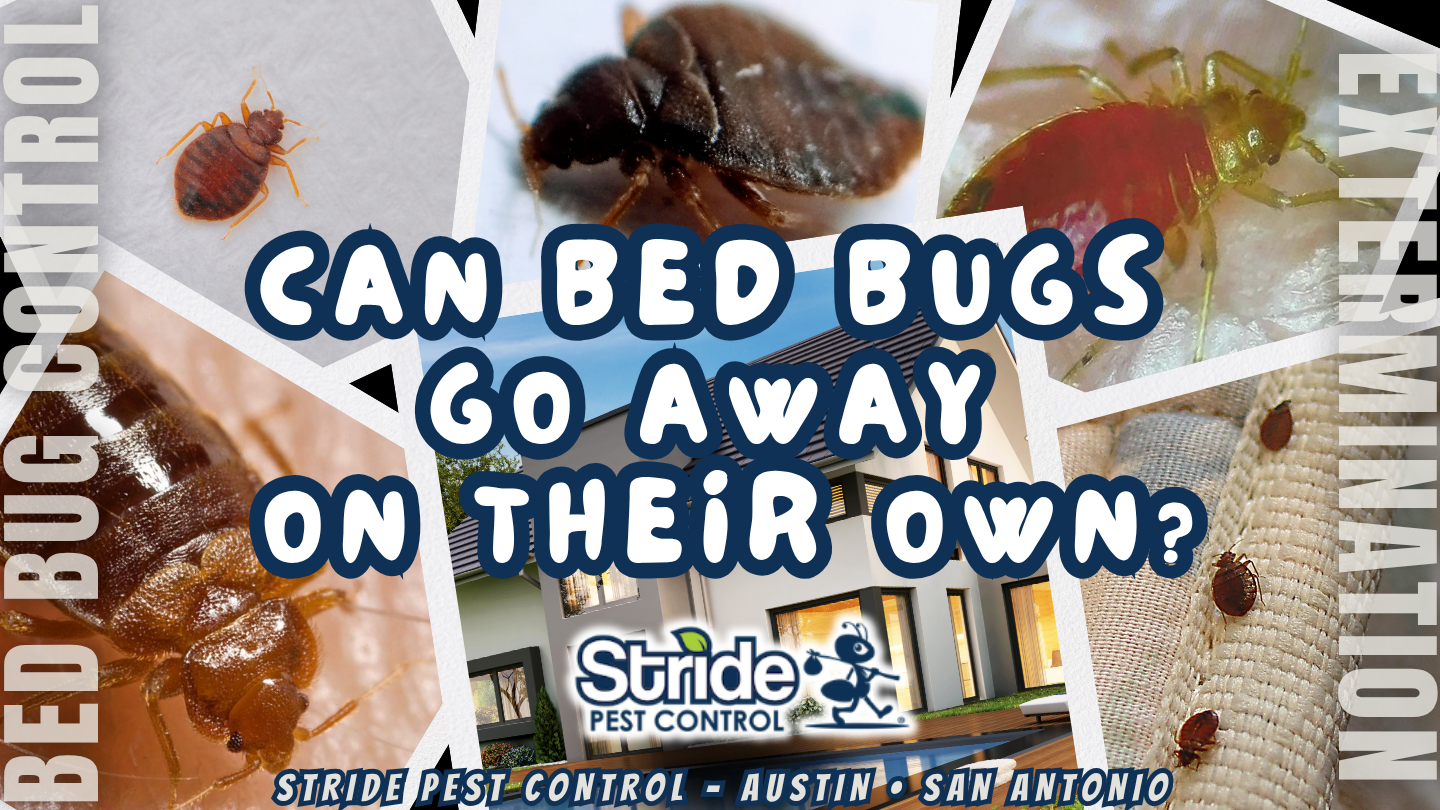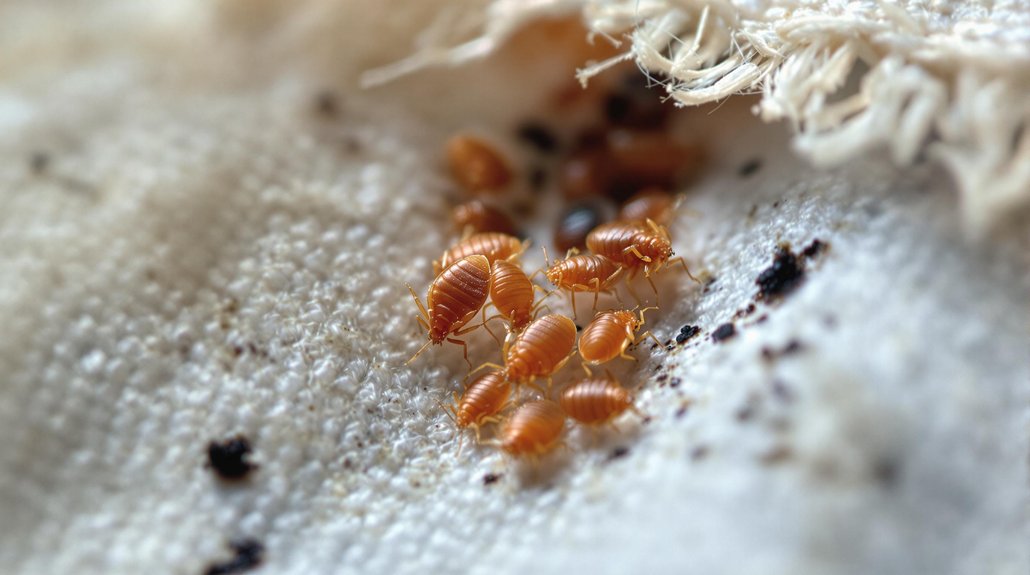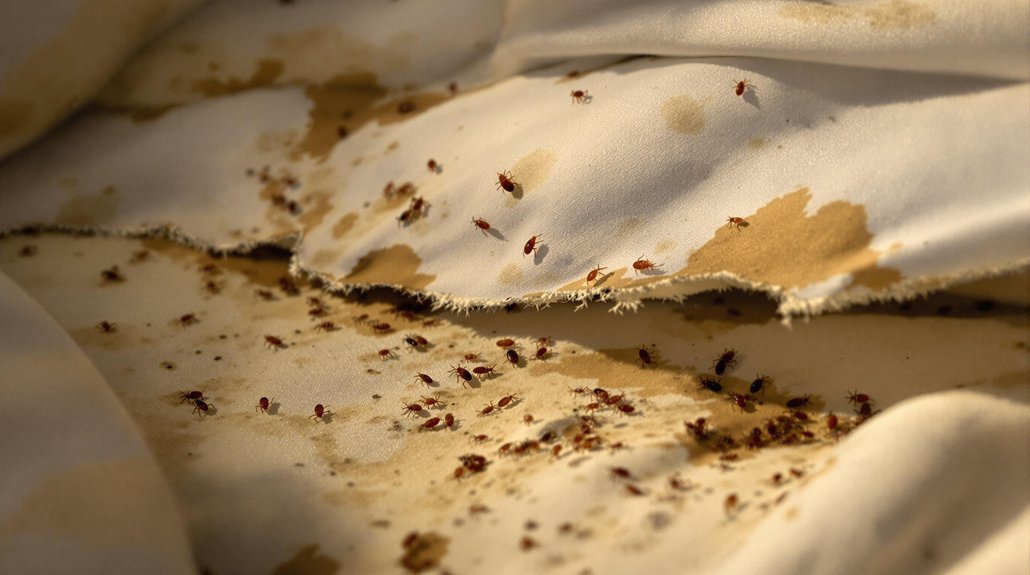
Bed bugs do not go away on their own. They rely on human blood and hide in tight spaces, making natural elimination impossible. Without treatment, infestations usually get worse over time. They can’t escape or leave by themselves, and their populations grow quickly. If left alone, problems become larger and harder to fix. To keep pests at bay, it’s best to know what methods work—more tips are just ahead.
Key Article Highlights
- Bed bugs rarely leave on their own because they prefer dark hiding spots near their food source.
- Without intervention, their population can grow rapidly, making natural disappearance unlikely.
- They are resistant to many chemicals, so infestations often persist without treatment.
- Bed bugs depend on humans for feeding, but they tend to stay hidden rather than escaping.
- Professional control is usually necessary, as natural elimination is slow and unreliable.
Understanding Bed Bug Behavior and Life Cycle

Bed bugs are small insects that go through several stages in their life cycle, starting as eggs before becoming nymphs and finally adults. Their behavior is focused on feeding, hiding, and reproducing. Bed bugs are nocturnal, coming out at night to bite humans and feed on blood. During the bed bug life cycle, eggs hatch into nymphs, which must feed multiple times to grow into adults. These insects prefer dark, tight spaces like mattress seams, furniture cracks, or baseboards. Their ability to hide effectively helps them survive long periods without feeding, but their activity patterns revolve around seeking blood meals. Understanding bed bug behavior and their life cycle is essential for effective control, as it reveals their resilience and habit of remaining hidden during most of their development stages. Additionally, their resistance to certain chemicals can make eradication more challenging without proper treatment methods.
Why Bed Bugs Do Not Typically Leave on Their Own
Bed bugs usually stay put because they have no natural predators to keep them in check. They also find it hard to escape since their hiding spots are limited and hard to reach. Plus, their quick reproduction keeps their numbers high, making it unlikely for them to leave on their own.
Lack of Natural Predators
Without natural predators to keep their numbers in check, bed bugs tend to persist once they infest an area. In natural ecosystems, predator relationships help control pest populations, but bed bugs lack significant natural enemies in human habitats. They are highly adapted to survive close to humans, making it unlikely for predators to recognize or target them. This absence of predators means bed bugs don’t face natural checks on their growth, allowing infestations to grow unchecked over time. Unlike insects that are kept in balance by predator-prey dynamics, bed bugs rely mainly on their reproduction and survival skills. Their survival is not hindered by predators, which contributes to their stubborn persistence in homes and hotels, making self-resolution highly unlikely without intervention.
Limited Escape Routes
Despite their stubbornness and lack of natural enemies, bed bugs are not quick to leave an infested area on their own. Their escape behavior is limited because they have many hiding places and prefer to stay close to their food source—humans. Bed bugs tend to hide during the day in cracks, crevices, furniture, and bedding, making it difficult for them to find open routes out of a space. Since they are expert hiders, their escape routes are naturally restricted; they don’t tend to venture far or seek new shelters on their own. This limited movement means they usually remain close to their original hiding spots, rather than fleeing the area entirely, which explains why they rarely leave an infestation without human intervention.
Persistent Reproduction Cycles
Bed bugs are resilient because they reproduce quickly and continuously. Their reproductive patterns enable their populations to grow rapidly, making natural decline unlikely. Each female bed bug can lay dozens of eggs in a single cycle, ensuring steady population growth. These persistent reproduction cycles sustain the population’s dynamic nature, with new generations emerging before old ones are eliminated. Because of this, they can maintain or even increase their numbers without intervention. The ongoing reproduction keeps their population dynamic and difficult to control, preventing them from leaving on their own. Their ability to reproduce constantly means they are unlikely to disappear naturally, requiring proactive measures to break their cycle of growth. Without intervention, their population will continue to thrive and spread.
Factors That Might Temporarily Reduce Bed Bugs
Harsh environmental conditions and limited food sources can temporarily reduce bed bugs. Extreme heat or cold may kill some bugs, while a lack of nearby hosts can cause them to hide elsewhere. However, these factors usually don’t completely eliminate a bed bug infestation.
Harsh Environmental Conditions
Extreme environmental conditions can sometimes make life difficult for bed bugs and lower their numbers temporarily. These conditions include factors like extreme temperatures or humidity levels that are outside their comfort zone. Such harsh environments can kill or drive bed bugs away temporarily, but they rarely eliminate them completely.
Some key factors are:
- Very high or low temperatures—above 113°F or below 0°F—can kill bed bugs quickly.
- Low humidity levels cause dehydration and weaken their survival.
- Excessive heat from direct sunlight or heat treatments can be effective.
- Cold temperatures sustained over days can also reduce their numbers.
While these conditions can reduce infestations temporarily, bed bugs often find places to hide, making full eradication unlikely through environmental exposure alone.
Limited Food Sources
When food sources become scarce, bed bugs may reduce their activity and move less often. Food scarcity causes these pests to adopt survival strategies, conserving energy until they find a suitable blood meal again. During this period, they may hide or stay still longer, making them less noticeable. Bed bugs rely on regular blood meals to survive, so a lack of hosts can temporarily hinder their ability to reproduce and spread. This slowdown may last weeks to months, depending on how long they can survive without feeding. However, they rarely go away completely on their own, as their adaptability allows them to survive under limited food sources. Temporary food scarcity can buy some time, but it doesn’t eliminate the infestation permanently.
The Risks of Letting Bed Bugs Go Unattended

Leaving bed bugs untreated can lead to bigger problems. An unchecked infestation can grow quickly, making removal harder and more expensive. Ignoring bed bug infestations also increases health risks, including skin bites, allergic reactions, and potential infections from scratching. Here are some key risks:
- Infestation Spread: Bed bugs multiply fast, spreading to neighboring rooms and furniture.
- Increased Discomfort: Bites cause itching, swelling, and inflammation, disrupting sleep.
- Health Hazards: Persistent bites can lead to infections or allergic reactions.
- Psychological Stress: Ongoing infestations cause anxiety and disturb daily life.
Failing to address bed bug infestations promptly makes eradication tougher and elevates health risks, highlighting the need for early treatment.
The Importance of Early Detection and Treatment
Early detection and prompt treatment are key to managing bed bug problems effectively. Recognizing signs early, such as bites, shed skins, or blood spots on bedding, is vital for quick action. The treatment importance lies in stopping the infestation before it spreads further. The longer bed bugs are left untreated, the more difficult and costly it becomes to eliminate them. Early detection helps prevent infestations from growing deep into furniture, walls, or other hidden spaces. Acting quickly also reduces discomfort and health risks associated with bites and allergic reactions. Overall, staying vigilant and addressing issues promptly are essential steps in controlling bed bugs, saving time, money, and frustration. Mastering early detection is the most effective way to manage these pests.
Effective Methods for Getting Rid of Bed Bugs

Eliminating bed bugs requires a combination of methods to guarantee all hiding spots are covered. DIY treatments and natural remedies can be effective when used correctly. Here are some strategies:
- Vacuum thoroughly – focus on mattresses, furniture, and carpets.
- Wash and dry bedding and fabrics – use hot water and high heat to kill bugs.
- Use natural remedies – like diatomaceous earth or essential oils (tea tree, peppermint).
- Seal cracks and crevices – block hiding spots to limit their movement.
These methods work best when combined, ensuring bed bugs can’t find safe hiding places. While natural remedies can help reduce infestations, persistent or severe bugs may require professional help. Consistency and thoroughness are key to success.
Professional Pest Control: When and Why It’s Necessary
Professional pest control becomes necessary when DIY pest control or bed bug extermination efforts don’t work, especially with severe infestations. A DIY approach might slow down the problem but often won’t fully eradicate the pests. When bugs keep coming back or spread to multiple rooms, professional help is the best choice. Pest control experts use specialized equipment and insecticides that homeowners can’t access. They also understand bed bug behavior and hiding spots. Here’s when to call in professionals:
| Situation | Reason |
|---|---|
| DIY pest control fails | Infestation persists or worsens |
| Severe infestation | Large populations, hard to treat beds |
| Re-infestation after DIY | Bugs return despite home treatments |
| Bed bug sightings in multiple rooms | Widespread problem |
| Limited time or expertise | Need quick, effective bed bug extermination |
Long-Term Prevention Strategies Against Bed Bugs
To prevent bed bugs from returning, it is important to follow consistent long-term strategies. These include preventive measures that address potential hiding spots and reduce infestation risk.
Consistent long-term strategies are essential to prevent bed bugs from returning.
- Use mattress encasements and clutter reduction to limit hiding places.
- Conduct regular inspections and vacuum cleaning to catch early signs.
- Apply heat treatments or essential oils as natural deterrents.
- Practice travel precautions and pest proofing techniques to avoid bringing bugs home.
Additionally, education resources can help stay informed about new methods and early detection. Maintaining a tidy environment and being proactive with these preventive measures are key. Combining these tactics guarantees a more effective, long-term defense against bed bugs and helps prevent future infestations.

